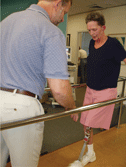Spinal Rehabilitation
Coast Physical Therapy helps treat various conditions of the spine: chronic neck, upper back and lower back pain and stiffness, sacroiliac dysfunction, disc pathology/injury, herniated and degenerative discs, pre- and post-surgical rehabilitation, stenosis, spondylolithesis and scoliosis, whiplash, and spine-related sports or work injuries.
We use various techniques to expedite recovery suited to each individual's needs, including, but not limited to:
Stroke Rehabilitation
Recovery from a stroke depends on the size and location of the stroke, how quickly you received care, and your other health conditions. Your Coast Physical Therapist will develop an individualized plan to help you achieve the best possible quality of life. The plan will involve a variety of treatments focusing on your ability to move, any pain you might have, and ways to prevent problems that may occur after a stroke.
Treatments include:
- strengthening exercises
- functional exercises
- balance training
- BioDex Balance System
- gait training
- mirror therapy
- biofeedback
With Mirror Therapy the patient places the good limb one side of the mirror, and the weak limb on the other. The patient looks into the mirror and makes movements. Because the patient is seeing the reflected image of the good hand moving, it appears as if the weak or phantom limb is also moving. Through this visual feedback it becomes possible to "cross-train the brain" to improve movements of the weak limb and to also "move" a phantom limb, and unclench it from potentially painful positions.
Neuromuscular Re-Education
Neuromuscular reeducation is a general term that refers to techniques that attempt to retrain the neuromuscular system to function properly. The basis of this idea is that the formation of certain patterns of communication between muscles and nerves allow people to perform simple everyday acts such as climbing stairs. These normal patterns of movement can be disrupted by injuries or may be impaired in people with certain medical conditions. Our aim is either to re-establish normal patterns of movement in injured people or to create normal patterns of movement in disabled people, by practicing a variety of exercises.
Balance Screening and Training
Balance Training program is available for patients with various vestibular problems, including central and/or peripheral vestibular dysfunction, and paroxysmal vertigo. Balance training is also available for patients with unsteady gait and history of falls. This program is especially beneficial for elderly patients who have balance problems and would like to prevent injuries from falling.
Techniques and Therapies we commonly use include:
Gait Training
Gait training can take a number of forms, but repetition of the actual motions performed during walking is the most important factor. We use parallel bars to help with gait training, especially in the early stages when a patient is first learning or re-learning to walk. They are two handrails to help a patient support themselves, often with us either helping to support the patient or physically moving the patient's legs. Although gait training with parallel bars can be beneficial, the long-term aim of gait training is usually to reduce a patient's dependence on such technology in order to walk more in their daily lives.
Traction - Mechanical and Manual
Traction refers to the set of mechanisms for straightening broken bones or relieving pressure on the spine and skeletal system. At Coast Physical Therapy we most often use traction to help treat cervical/neck and lumbar/lower back problems. Types of traction available are Manual, Mechanical, and Inversion.
Traction benefits may include:
- regaining normal alignment of involved bone
- decrease or eliminate muscle spasms
- relieve pressure on nerves
- pain relief
Total Motion Release (TMR)
Here at Coast Physical Therapy we use the latest and most effective techniques for the best results. The Total Motion Release Technique takes an nontraditional but effective approach to Physical Therapy. It allows the body to naturally re-align and heal, which proves to be more effective. The Total Motion Release Technique provides almost instant results and relief to your aches and pains. Once you’ve grasped the concept, you have a lifetime tool to help treat your pains and discomforts.
When you have pain in your right shoulder it makes sense to treat your right shoulder, correct? With Total Motion Release we make this statement incorrect. Instead of treating motions that cause pain in the aching right shoulder, Total Motion uses a little known secret of treating pain free motions in the left shoulder. This causes a re-aligning of both shoulders and alleviates your pain. Visit Total Motion website to learn more.
Joint Mobilization
Joint manipulation is a type of passive movement of a skeletal joint. It is usually aimed at one or more 'target' synovial joints with the aim of achieving a therapeutic effect. The clinical effects of joint manipulation have been shown to include:
- Temporary relief of musculoskeletal pain.
- Increase in passive range of motion (ROM).
- No alteration of the position of the sacroiliac joint.
Strengthening, Stretching, Range of Motion
At Coast Physical Therapy Strengthening, Stretching, and increasing Range of Motion are integral parts of physical therapy. Each physical therapy program is tailored to help the individual achieve his or her full potential.
Weak muscles due to lack of activity, hospitalization, or surgery can make simple everyday activities hard or even impossible to perform. Weak muscles increase the risk of falls, prevents proper healing, and increases risk of further injury. Strengthening exercises are prescribed to prevent further injury, prevent falls, and to reduce pain. Your individual program at Coast Physical Therapy may include exercise machines, free weights, elastic bands, or your own body to build strength.
Muscle “tightness” limits Range of Motion, may create a muscle imbalance, limits the body's functioning and can cause further injury. We use many effective passive and active techniques, including static, dynamic, and pre-contraction stretches to reduce pain and prevent further injury caused by muscle tightness.
